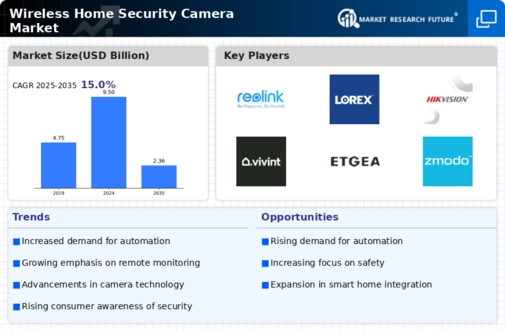The Wireless Home Security Camera Market is currently characterized by a dynamic competitive landscape, driven by technological advancements and increasing consumer demand for enhanced security solutions. Key players such as Ring (US), Arlo Technologies (US), and Reolink (CN) are at the forefront, each adopting distinct strategies to solidify their market positions. Ring (US) continues to innovate with its integration of smart home technologies, while Arlo Technologies (US) focuses on expanding its product line to include advanced AI features. Reolink (CN), on the other hand, emphasizes affordability and user-friendly designs, appealing to a broader consumer base. Collectively, these strategies contribute to a competitive environment that is both innovative and responsive to consumer needs.
In terms of business tactics, companies are increasingly localizing manufacturing and optimizing supply chains to enhance efficiency and reduce costs. The market structure appears moderately fragmented, with several players vying for market share. This fragmentation allows for diverse offerings, yet the influence of key players remains substantial, as they set trends and standards that smaller companies often follow. The collective actions of these major companies shape the market dynamics, fostering an environment where innovation and customer-centric approaches are paramount.
In September 2025, Arlo Technologies (US) announced the launch of its latest line of security cameras featuring enhanced AI capabilities for motion detection and facial recognition. This strategic move is significant as it positions Arlo to cater to the growing consumer demand for smart home integration, potentially increasing its market share in a competitive landscape. The emphasis on AI not only enhances user experience but also aligns with broader trends in digital transformation within the security sector.
In August 2025, Ring (US) expanded its partnership with Amazon (US) to integrate its security cameras with Amazon's Alexa ecosystem. This collaboration is pivotal, as it allows Ring to leverage Amazon's vast customer base and distribution network, thereby enhancing its market reach. The integration with Alexa also signifies a shift towards more interconnected smart home solutions, which could drive consumer adoption and loyalty.
In July 2025, Reolink (CN) introduced a new line of budget-friendly security cameras aimed at first-time buyers. This strategic decision reflects Reolink's commitment to accessibility in home security, potentially attracting a demographic that may have previously considered such technology out of reach. By focusing on affordability without compromising quality, Reolink is likely to strengthen its position in the market, appealing to cost-conscious consumers.
As of October 2025, the competitive trends within the Wireless Home Security Camera Market are increasingly defined by digitalization, sustainability, and the integration of artificial intelligence. Strategic alliances, such as those between Ring and Amazon, are shaping the landscape, fostering innovation and enhancing product offerings. Looking ahead, it appears that competitive differentiation will evolve, with a notable shift from price-based competition to a focus on technological innovation, reliability in supply chains, and enhanced customer experiences. This evolution suggests that companies prioritizing these aspects may gain a competitive edge in the increasingly crowded market.
















Leave a Comment